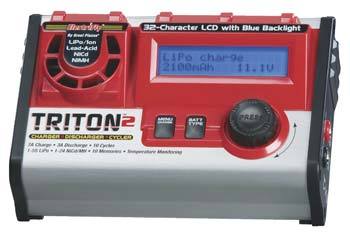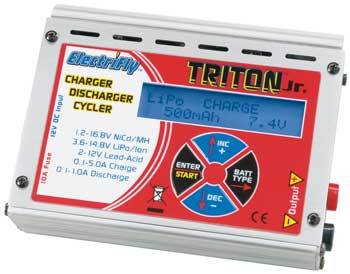I very much agree with md10bldr. If the 3pi is the only thing you’re ever going to use with rechargeable batteries than a cheap one-purpose charger is totally fine. I played around with individual chargers specific to battery pack chemistry and number of cells for years, and in hindsight I wish I had picked up a good all-purpose charger like a Triton long ago.


The Triton 2 is a fantastic charger, but its probably more capability than you need. I recently picked up a Triton Jr at my local hobby store, and I couldn’t be happier with it. It’s smaller than the Triton 2, costs less (TJr: ~$75, T2: ~$130), and is quieter. The Triton 2 has a fan that is on during all charging/discharging, while the Triton Jr is essentially an aluminum heat-sink with a charger inside. If you’re going to be good stay around while your batteries while they charge, you might not want to have to listen to the fan.
The Jr doesn’t have the extreme capabilities of the Triton 2 (for example: lower max charge and max discharge currents, the TJr will only charge up to 12V lead-acid batteries, the T2 will charge 24V packs, the TJr can charge up to a 4 cell Li-Po or Li-Ion pack, the T2 can charge a 5-cell pack, etc), but it’s still incredibly versatile. I would equate this to the difference between a car that can go 100MPH and a car that can go 150MPH. Some people do actually want/need the extra speed of the faster car, but the slower car is still plenty fast for the vast majority of driving.
That said, I was having still having trouble deciding which one to buy, until I talked to a friend who had bought a TJr, returned it (store credit only) and bought a T2, then regretted it and wanted his TJr back. He has offered to trade me his T2 for my TJr (plus the difference in cost), but I haven’t taken him up on it…yet.
-Adam
P.S. As the previous post mentions, keep in mind that, as with most/all professional battery chargers, you will need a separate DC power supply for either Triton. The T2 manual says:
Before you drop $50-$100 or more on a power supply, keep in mind that you can scavenge one form an old PC tower. I haven’t yet felt the need for “absolute maximum output power” anyway, and cheap 12V 3A switching desktop power supplies like one of the ones here work just fine.


